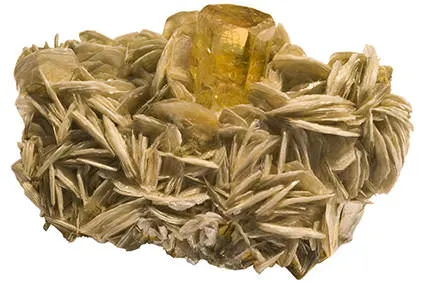 Heliodor is a golden yellow stone that was first discovered at Rossing, Erongo, Western Namibia in 1910. Heliodor is a form of
Heliodor is a golden yellow stone that was first discovered at Rossing, Erongo, Western Namibia in 1910. Heliodor is a form of ![]() beryl, and is actually the most brilliant form of all the beryls. Because of the stone's unusually vibrant yellow color, it was given the name heliodor, from the Greek words helios and doron, meaning, gift from the sun. Heliodor in fact, has always been linked with the sun. Initially, only golden beryl found in Namibia was called heliodor, but today the name is applied almost indiscriminately to all the different varieties of yellow and gold beryl. Technically, however, the name should only apply to heliodor. What makes heliodor different than other yellow shades of beryl, is that it gets its vibrant color from trace iron impurities.
beryl, and is actually the most brilliant form of all the beryls. Because of the stone's unusually vibrant yellow color, it was given the name heliodor, from the Greek words helios and doron, meaning, gift from the sun. Heliodor in fact, has always been linked with the sun. Initially, only golden beryl found in Namibia was called heliodor, but today the name is applied almost indiscriminately to all the different varieties of yellow and gold beryl. Technically, however, the name should only apply to heliodor. What makes heliodor different than other yellow shades of beryl, is that it gets its vibrant color from trace iron impurities.
 Heliodor is a popular stone amongst collectors as it is not common on the market. In fact, collectors value heliodor at least as highly as they do
Heliodor is a popular stone amongst collectors as it is not common on the market. In fact, collectors value heliodor at least as highly as they do ![]() aquamarine. Although Heliodor was distinguished as a form of
aquamarine. Although Heliodor was distinguished as a form of ![]() beryl by the Roman historian Pliny the elder, it is still sometimes confused as bright yellow
beryl by the Roman historian Pliny the elder, it is still sometimes confused as bright yellow ![]() topaz. Heliodor rates a 7.5 to 8 on the hardness scale. It is a brittle, vitreous, and transparent to translucent stone. The main characteristic of heliodor is its color, sometimes described as similar to the yellow-green of olive oil. Its yellow shade may vary considerably, so it's difficult to establish a dividing line between heliodor and golden beryl. Heliodor most commonly occurs as an accessory mineral in granites, and is usually found in cavities and in granite pegmatites. Heliodor crystals in some pegmatites grow to extremely large sizes, sometimes even up to 30 feet. The stone is often found associated with aquamarine. Heliodor is famous for its perfect golden crystals and is commonly associated with
topaz. Heliodor rates a 7.5 to 8 on the hardness scale. It is a brittle, vitreous, and transparent to translucent stone. The main characteristic of heliodor is its color, sometimes described as similar to the yellow-green of olive oil. Its yellow shade may vary considerably, so it's difficult to establish a dividing line between heliodor and golden beryl. Heliodor most commonly occurs as an accessory mineral in granites, and is usually found in cavities and in granite pegmatites. Heliodor crystals in some pegmatites grow to extremely large sizes, sometimes even up to 30 feet. The stone is often found associated with aquamarine. Heliodor is famous for its perfect golden crystals and is commonly associated with ![]() quartz feldspars and muscovite mica.
quartz feldspars and muscovite mica.
 Heliodor can be found in various locations around the world; in the Ukraine, Namibia, Minas Gervais in Southeast Brazil, Rangkul in the Tian Shan Mountains in Northeast Tajikistan, Mursinsk, in the Ural Mountains in central Russia, and in Nasarawa State in Northern Nigeria. In the United States, heliodor can be found in Litchfield County, Connecticut. The best specimens of the stone come from Namibia, but some can also be found in Madagascar and Brazil. Brazilian heliodor is often of a pale yellow shade and is step cut to give the stone more depth of color. Heliodor from Madagascar is of a finer, brighter color.
Heliodor can be found in various locations around the world; in the Ukraine, Namibia, Minas Gervais in Southeast Brazil, Rangkul in the Tian Shan Mountains in Northeast Tajikistan, Mursinsk, in the Ural Mountains in central Russia, and in Nasarawa State in Northern Nigeria. In the United States, heliodor can be found in Litchfield County, Connecticut. The best specimens of the stone come from Namibia, but some can also be found in Madagascar and Brazil. Brazilian heliodor is often of a pale yellow shade and is step cut to give the stone more depth of color. Heliodor from Madagascar is of a finer, brighter color.
 Heliodor has been called the stone of the gods and the gateway to light. The warm yellow color of the stone has been said to enhance the wearer's intuition and compassion. It can help us to break through to our own inner strength and make us feel responsible for our own lives, becoming knowledgeable about the laws of life. The stone can also help us develop maturity and rise to our potential greatness, allowing us to feel prepared for anything. Heliodor can be oiled or heat-treated. Heat treatment can eliminate the stone's yellow tint, resulting in a clear or even
Heliodor has been called the stone of the gods and the gateway to light. The warm yellow color of the stone has been said to enhance the wearer's intuition and compassion. It can help us to break through to our own inner strength and make us feel responsible for our own lives, becoming knowledgeable about the laws of life. The stone can also help us develop maturity and rise to our potential greatness, allowing us to feel prepared for anything. Heliodor can be oiled or heat-treated. Heat treatment can eliminate the stone's yellow tint, resulting in a clear or even ![]() aquamarine blue stone. Irradiation can reverse this effect.
aquamarine blue stone. Irradiation can reverse this effect.